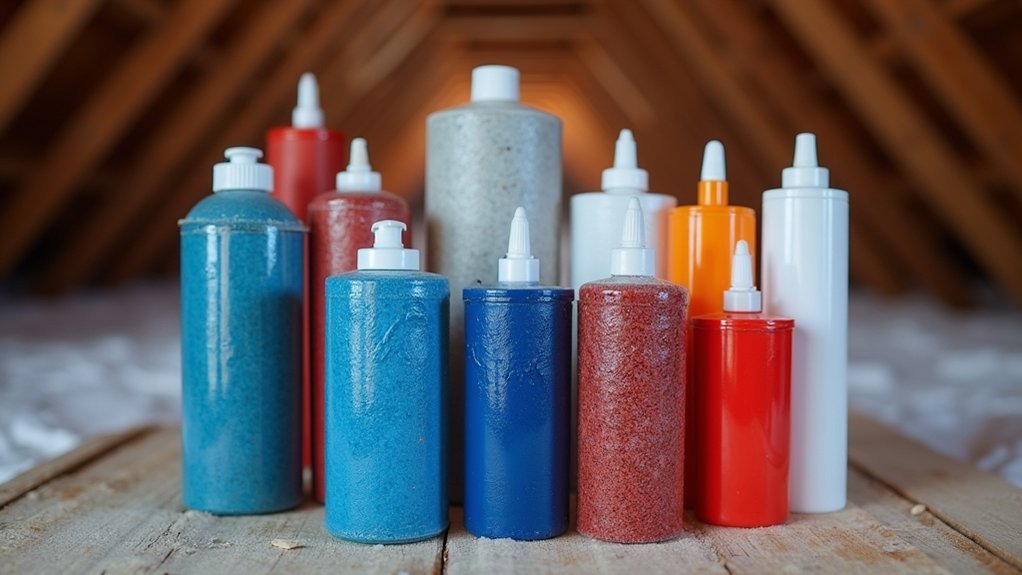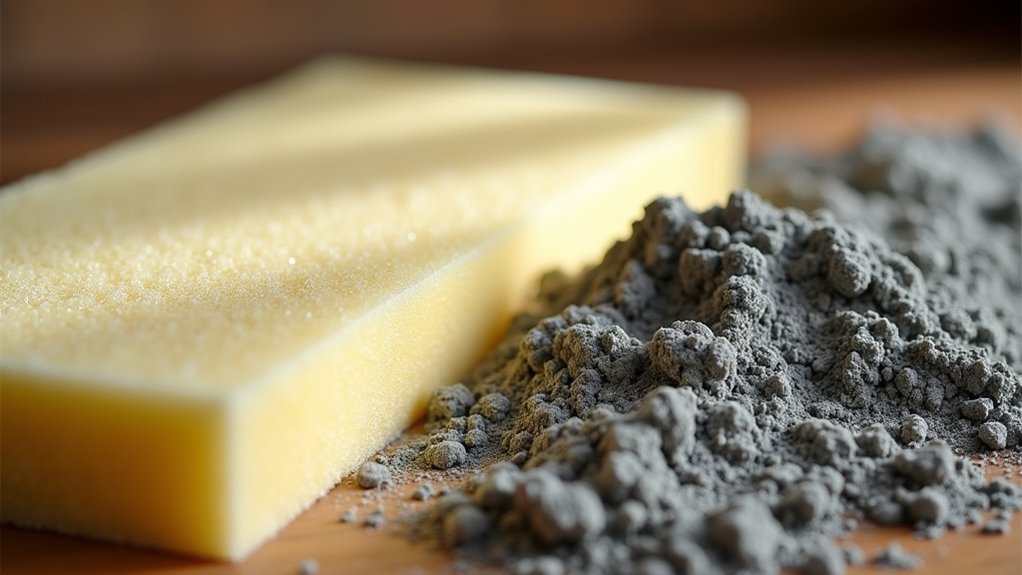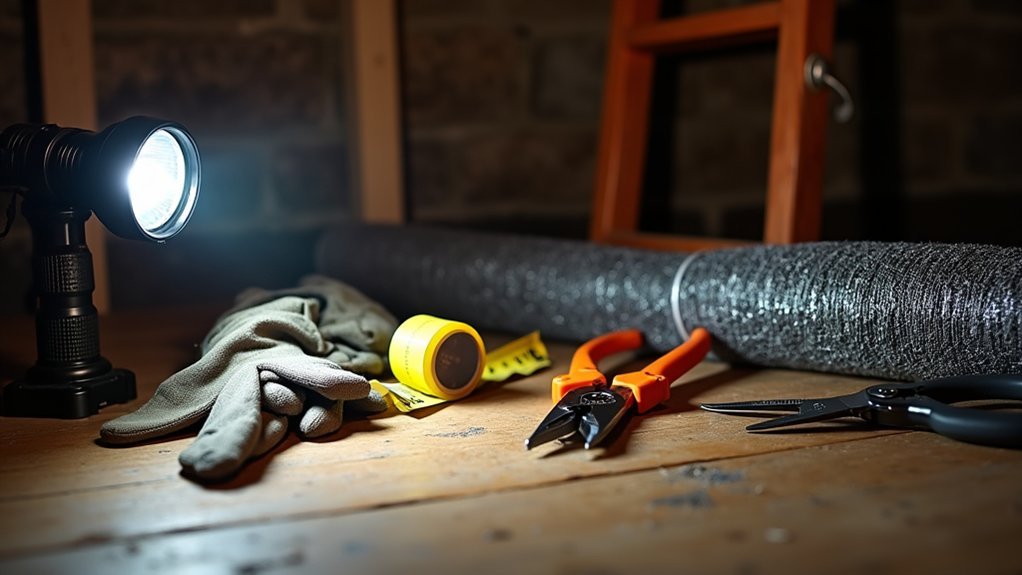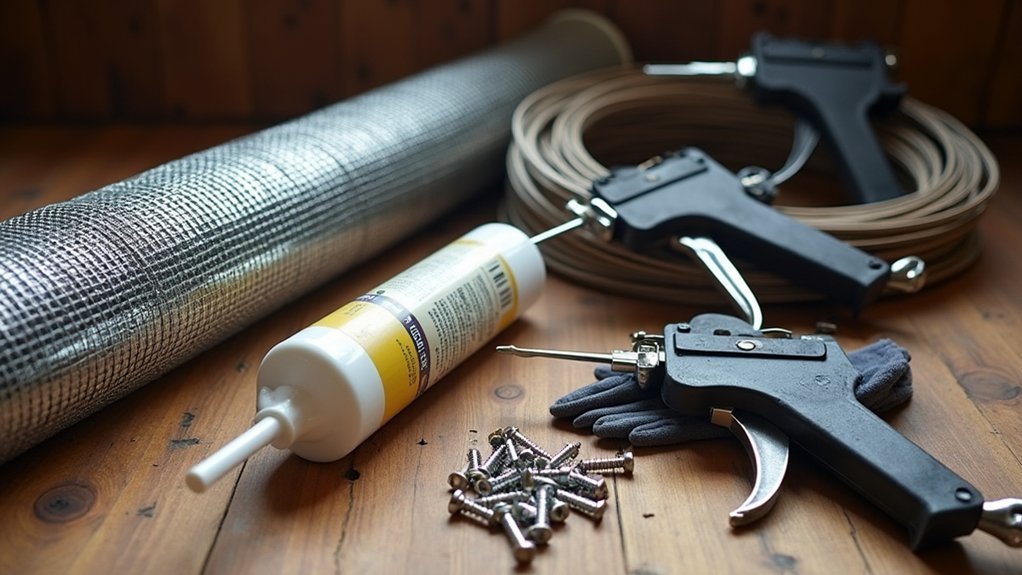Effective attic rodent exclusion requires several key materials. You’ll need heavy-duty sealants and caulking compounds for gaps, steel wool and metal mesh barriers for larger openings, and expanding foam for cracks. Don’t forget specialized vent and chimney guards, door sweeps, and weather stripping. Essential tools include flashlights, moisture meters, and safety equipment like gloves and masks. The right materials make all the difference in creating a rodent-proof home.
Heavy-Duty Sealants and Caulking Compounds

When rodents attempt to invade your attic, they’ll first look for gaps and cracks larger than 1/4 inch to squeeze through. To prevent rodent entry, you’ll need specialized heavy-duty sealants and caulking compounds designed specifically for pest exclusion.
Choose silicone sealants or polyurethane sealants for their superior flexibility and durability against temperature fluctuations. These materials maintain their integrity year-round without cracking or losing adhesion. Look for formulations with gnawing resistance additives that create effective barriers against determined pests that easily chew through wood and plastic.
Before applying any rodent-proof compounds, thoroughly clean all vulnerable entry points to guarantee proper bonding. Dirt can compromise even the best sealants.
For extensive protection, use a combination of different caulking compounds at various locations where utilities enter your home or where building materials meet.
Steel Wool and Metal Mesh Barriers
Steel wool offers an effective solution for caulking entry points where rodents might squeeze through, as its expandable fibers create an impenetrable barrier that rats and mice can’t chew through.
You’ll find that combining steel wool with caulk provides double protection, with the steel wool blocking the entry and the caulk sealing it permanently against moisture and drafts.
For larger openings, hardware cloth applications provide superior coverage, where you can cut the galvanized metal mesh to size and secure it over vents, eaves, and other potential access points with screws or staples.
Caulking Entry Points
Since rodents can squeeze through surprisingly small openings, properly sealing entry points is essential for effective attic exclusion. When caulking, first identify all potential access points by thoroughly inspecting your home.
Combine silicone or latex caulk with steel wool for a robust rodent-proof barrier—the caulking adheres the steel wool in place while providing a weather-resistant seal.
For larger openings, install metal mesh barriers before applying caulk around the edges. These gnaw-resistant materials prevent rodents from chewing through your defenses.
Remember to seal any gaps thoroughly, as mice can enter through holes as small as a dime.
Don’t forget to regularly check your work for signs of wear or deterioration. Maintaining intact barriers is vital for long-term rodent exclusion success, especially in areas exposed to weather or frequent rodent activity.
Hardware Cloth Applications
Although often overlooked, hardware cloth serves as one of the most effective rodent exclusion materials available to homeowners. This welded wire mesh provides exceptional durability and gnawing resistance, making it ideal to seal entry points where rodents attempt to access your attic.
When installing hardware cloth, you’ll need to secure surfaces tightly, ensuring all joints overlap to eliminate potential gaps. Combine it with steel wool to address smaller cracks—its fibrous texture creates an additional barrier rodents can’t chew through.
For exterior applications, choose galvanized metal mesh barriers that resist rust while protecting vents, chimneys, and foundation gaps.
For thorough protection, integrate hardware cloth with other rodent-proofing techniques like concrete for larger openings or specialized sealants. This multi-material exclusion strategy offers the most effective defense against persistent attic invaders.
Expanding Foam and Concrete Patching Materials

When securing your attic against unwanted rodent visitors, expanding foam and concrete patching materials serve as essential defense tools in your pest control arsenal. Choose rodent-proof expanding foam formulas specifically designed to fill gaps and cracks up to 1/2 inch wide, creating barriers rodents can’t penetrate.
For larger structural repairs, concrete patching materials provide a gnaw-resistant surface that effectively blocks rodent entry points. Combine both materials for thorough protection around your attic’s vulnerable areas.
| Material | Best Used For | Curing Time |
|---|---|---|
| Expanding Foam | Gaps up to 1/2″ | 24 hours |
| Concrete Patch | Foundation holes | 48 hours |
| Combination | Critical entry points | 48+ hours |
Both solutions offer quick application and excellent insulation benefits while maintaining your home’s structural integrity against persistent rodent intrusions.
Specialized Vent and Chimney Guards
Specialized vent screening options like quarter-inch galvanized mesh provide long-term protection against rodents while maintaining proper airflow through your home’s ventilation system.
When selecting chimney caps, you’ll want to choose models with secure fittings and weather-resistant materials that prevent both rodent entry and water intrusion.
These specialized exclusion materials offer significant benefits over standard solutions, including extended durability in harsh weather conditions and greater resistance to gnawing attempts by persistent rodents.
Vent Screening Options
Because they serve as essential barriers against unwanted invaders, specialized vent and chimney guards represent one of your most significant investments in rodent exclusion.
When selecting vent screening for your attic, opt for products made from galvanized or stainless steel mesh that’s rodent-proof while maintaining proper airflow. These materials resist both rust and rodent gnawing attempts.
For maximum protection, look for screening with small mesh openings that prevent rodents from squeezing through yet don’t impede ventilation.
Some advanced options feature automatic closing mechanisms—flaps or weighted designs that seal entry points when vents aren’t in use.
Remember that proper installation is vital for effectiveness, as even small gaps can compromise your entire rodent prevention strategy.
Schedule regular inspections to guarantee your vent screening remains intact, protecting both your attic insulation and home from costly rodent infestations.
Chimney Cap Selection
While many homeowners focus on sealing obvious entry points, your chimney remains a vulnerable access route for determined rodents seeking shelter. Selecting the right rodent-proof chimney cap is crucial for complete attic protection. Choose caps made from stainless steel or galvanized steel that resist rust and withstand harsh weather.
| Feature | Requirement | Benefit | Maintenance |
|---|---|---|---|
| Material | Stainless/galvanized steel | Durability against elements | Check for rust annually |
| Mesh Screen | ≤ 1/4 inch openings | Block rodents effectively | Clean debris seasonally |
| Design | Secure fit with overhang | Prevents access points | Confirm proper attachment |
| Ventilation | Unobstructed airflow | Maintains chimney function | Verify smoke escapes properly |
For ideal rodent exclusion, confirm your chimney cap fits securely while maintaining proper ventilation. Regular inspections will verify the cap remains effective against unwanted visitors.
Specialized Material Benefits
Modern vent and chimney guards represent a critical line of defense against rodent invasion while offering several distinct advantages over makeshift solutions.
Constructed from specialized materials like galvanized steel or heavy-duty mesh, these guards effectively block openings larger than 1/4 inch, preventing rodent entry while maintaining proper ventilation to avoid moisture buildup in your attic.
You’ll find chimney caps with rodent-proof screens particularly valuable, as they prevent squirrels and wildlife from nesting inside, reducing fire hazards and ventilation blockages.
The variety of vent guards available guarantees you can secure a snug fit for all openings in your home.
Remember that regular maintenance is essential—inspect these barriers periodically to clear debris and maintain peak performance.
With these purpose-built solutions, you’ll maintain airflow while creating an effective rodent barrier.
Door Sweeps and Weather Stripping Solutions
Gaps beneath doors and around windows create perfect entryways for unwanted rodent guests. Install high-quality door sweeps made of durable vinyl or rubber to create a tight seal at thresholds, blocking mice that can squeeze through spaces as small as 1/4 inch.
Weather stripping applied around door frames and windows eliminates drafts while simultaneously creating rodent-proof barriers.
When selecting materials, prioritize durability—quality vinyl and rubber products provide superior insulation and longer-lasting protection. Consider adding metal kick plates to vulnerable areas for enhanced defense against gnawing rodents.
Remember that even the best exclusion materials require regular inspections to maintain effectiveness. Check all door sweeps and weather stripping periodically for signs of wear that might create new entry points.
Maintaining these simple barriers considerably reduces your home’s vulnerability to rodent invasions.
Inspection Tools and Safety Equipment

Before venturing into your attic to address rodent issues, you’ll need the right inspection tools and safety equipment to work effectively and protect yourself.
Thorough inspection is essential for successful pest control and preventing exposure to harmful bacteria.
- Illumination and Detection – Use a flashlight to spot rodent activity like droppings and gnaw marks in dark attic spaces, while a moisture meter identifies humidity issues that attract pests.
- Distance Observation – Binoculars help safely examine potential entry points on the roof without climbing.
- Documentation – A smartphone or digital camera captures evidence of infestation for later reference.
- Personal Protection – Always wear proper personal protective equipment including gloves, masks, and goggles to shield yourself from allergens and parasites present in rodent-infested areas.
Frequently Asked Questions
How Do I Make My Attic Rodent Proof?
You’ll need to seal all entry points, use metal guards for pipes and vents, store items in rodent-proof containers, maintain regular cleaning, and trim vegetation away from your home to effectively rodent-proof your attic.
What Materials Are Used for Rat Exclusion?
For rat exclusion, you’ll need galvanized steel mesh, rodent-proof sealants, hardware cloth with ¼-inch openings, concrete or masonry for permanent repairs, and metal flashing to prevent burrowing around your home’s perimeter.
What Can I Put in My Attic to Keep Mice Out?
You’ll need steel wool, copper mesh, rodent-proof sealants, hardware cloth for vents, and peppermint oil. Seal gaps thoroughly, protect openings with metal mesh, and use natural deterrents to keep mice out effectively.
What Is the Best Rodent Repellent for Attic?
You’ll find peppermint oil-based repellents most effective for your attic. They’re natural, safe, and mice hate the smell. Combine with ultrasonic devices for best results, but remember to reapply natural solutions regularly.
In Summary
Don’t underestimate the importance of proper materials for effective rodent exclusion. With the right sealants, mesh barriers, foam products, and guards in place, you’ll create a fortress against unwanted pests. Remember to use appropriate safety equipment during installation. By consistently maintaining these protective measures, you’re not just blocking entry points—you’re ensuring your attic remains rodent-free for years to come.





Leave a Reply